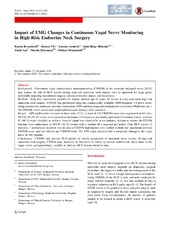| dc.description.abstract | Background: Continuous vagal intraoperative neuromonitoring (CIONM) of the recurrent laryngeal nerve (RLN) may reduce the risk of RLN lesions during high-risk endocrine neck surgery such as operation for large goiter potentially requiring transsternal surgery, advanced thyroid cancer, and recurrence. Methods: Fifty-five consecutive patients (41 female, median age 61 years, 87 nerves at risk) underwent high-risk endocrine neck surgery. CIONM was performed using the commercially available NIM-Response 3.0 nerve monitoring system with automatic periodic stimulation (APS) and matching endotracheal tube electrodes (Medtronic Inc.). All CIONM events (decreased amplitude/increased latency) were recorded. Results: APS malfunction occurred on three sides (3 %). A total of 138 CIONM events were registered on 61 sides. Of 138, 47 (34 %) events were assessed as imminent (13 events) or potentially imminent (34 events) lesions, whereas 91 (66 %) were classified as artifacts. Loss of signal was observed in seven patients. Actions to restore the CIONM baseline were undertaken in 58/138 (42 %) events with a median 60 s required per action. Four RLN palsies (3 transient, 1 permanent) occurred: one in case of CIONM malfunction, two sudden without any significant previous CIONM event, and one without any CIONM event. The APS vagus electrode led to temporary damage to the vagus nerve in two patients. Conclusions: CIONM may prevent RLN palsies by timely recognition of imminent nerve lesions. In high-risk endocrine neck surgery, CIONM may, however, be limited in its utility by system malfunction, direct harm to the vagus nerve, and particularly, inability to indicate RLN lesions ahead in time. | en_US |

